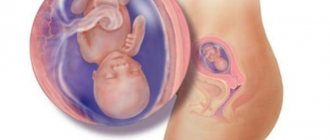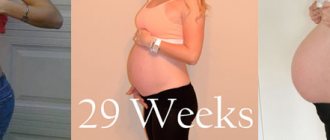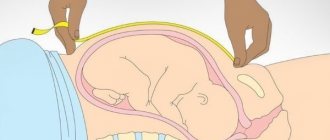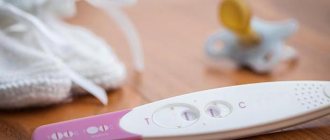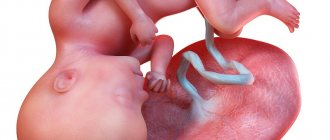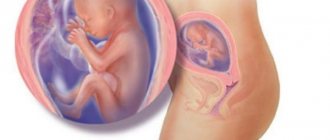Baby movements at 26 weeks
The twenty-sixth week of pregnancy is a time when the baby sleeps most of the day.
The rest period is a maximum of 18 to 21 hours. The rest of the time the fetus is awake and signals this with regular tremors. The baby has grown so much that with the help of movements he can signal his mother about his positive and sometimes negative emotions. Even the child's father and other household members can feel this by placing their hand on the belly of a pregnant woman. Doctors recommend that mothers and fathers monitor the frequency and intensity of the child’s movements every day. Too active or too weak tremors may be a reason for additional examination to make sure that the fetal vital signs are normal.
Fetal development
The baby's movements become more and more painful for the mother.
In most cases, the baby has already taken a position that is comfortable for him, in which he will be before birth (most often with his head down). In the later stages, there is no longer enough space in the uterus for him, and he will not rotate as before.
This is what your baby looks like at 26 weeks
Weight gain occurs due to increased muscle mass and accumulation of fat deposits. The skin is already almost smoothed and has a pink color.
The child already sees and can react to light and darkness differently, he lives in the world of sensations, receives his mother’s emotions and even dreams.
It reacts differently to the food the mother takes - it affects the taste of the amniotic fluid and affects the child’s taste preferences after birth.
The baby constantly listens to his mother’s heartbeat, her voice, even bowel sounds. Long after giving birth, the child will fall asleep to the beating of his mother’s heart, since for him this sound is associated with comfort and peace.
Further maturation of the lungs occurs. In boys, the testicles continue their journey into the scrotum.
The cartilages of the nose and ears are still soft, and the nails on the toes and hands do not reach the edges of the fingers.
Permanent teeth are formed and bones are strengthened.
Possible problems
Discharge at the 26th obstetric week
At the 26th week of pregnancy, small changes occur in the cervix associated with the appearance of a mucous plug, which protects the mother’s body from infection.
By this time, the plug becomes so dense that the discharge becomes much more abundant.
There is nothing wrong with this if you do not feel severe discomfort.
However, if you notice the appearance of colored discharge (yellow, green, dark brown), especially with clots of pus or blood, you should immediately call an ambulance. It must be remembered that normally the discharge should be whitish in color and without a strong odor.
Pain
Localization of pain can be observed in different parts of the body. Let us note that many women endure the third trimester quite easily and calmly, while some have a hard time due to various types of ailments:
- Pain in the abdominal area at this stage causes active movements of the child. Particularly favored places for thrusting are the ribs and bladder. As a rule, this is how the baby tells his mother that he is not happy with her location. You should change your position so that the child calms down.
- Pain in the uterus can also provoke ongoing muscle strain in this area. Also at this time, training contractions can be observed, preparing the woman’s body for the upcoming birth.
- Pain in the legs can appear due to various reasons: lack of calcium, excessive swelling, varicose veins. It is necessary to consult a doctor to alleviate your condition.
Uterus at 26 weeks of pregnancy
The ratio of the height and width of the uterus at the 26th week of pregnancy is about 25 cm and 17 cm. The woman’s belly is already protruding greatly - by about 6 cm. Such an impressive size of the organ that bears the fetus causes some inconvenience to the expectant mother. First of all, we are talking about compression of almost all nearby internal organs, including the bladder and stomach.
- Due to the effect that the uterus has on the organs of the gastrointestinal tract, a pregnant woman may face problems such as constipation and heartburn. Hemorrhoids become a frequent accompaniment of such troubles.
- At week 26, a woman may feel slight contractions of the uterus. These are Braxton Hicks contractions, which prepare the body for childbirth. There is no need to worry about this; such contractions do not pose a threat of miscarriage. If severe pain occurs, it is better to seek medical help.
- The mucus plug in the cervix begins its formation in the very first weeks after conception. After the sperm has merged with the female cell, the embryo (or blastocyst) is fixed in the uterus, in which a new life is born. All this is accompanied by a softening of the cervix, which is filled with mucus, which thickens during ovulation and thickens with each new cycle. By week 26, the plug has become firmly entrenched in the cervix, protecting against infections.
Fetal arrhythmia
Doctors can hear the fetal heartbeat in the womb using a stethoscope from about 19 weeks of pregnancy. If the contraction frequency is 120-160 beats per minute, then this is normal. If the rhythm does not fit within the normal range, the doctor diagnoses arrhythmia.
Heart rhythm disturbances in the fetus are not a reason to immediately sound the alarm and assume that the child has problems in the cardiovascular system. Doctors assure that a broken rhythm, if it occurs for a short time, is the norm. Over time, such failures will pass and everything will be fine. If the uneven heartbeat in the fetus does not go away, then the pregnant woman will have to undergo constant monitoring by specialists and drug treatment.
Ultrasound at 26 weeks of pregnancy
The screening ultrasound has already been done at this point. Only women who have not previously been screened or pregnant women who cause concern to the doctor are sent for the study.
Indications for referral to an ultrasound scan are discrepancies between the size of the uterus and the expected period, decreased or increased activity of the child, bloody discharge from the genital tract, or suspected infection of the fetus.
In this case, the fetal heart rate, its size, the amount of amniotic fluid, the condition of the placenta, and blood flow in the vessels are assessed.
Body changes and new sensations for women
Do your hands go numb during pregnancy, and do you feel pain, tingling and burning in your wrists? Such unpleasant sensations are familiar to many expectant mothers at 26 weeks of pregnancy. Most likely the reason lies in an imbalance in the amount of magnesium, calcium and potassium in the body. In this case, a woman should reconsider her diet and increase the consumption of fermented milk products, as well as vegetables, legumes and dried fruits. If swelling appears in the hands along with numbness, the so-called tunnel syndrome in pregnant women is present. The reason it occurs is as follows: excess fluid accumulates in the tissue and causes swelling, which then compresses the nerve. To relieve unpleasant symptoms, doctors advise mothers not to leave their hands in one position for a long time, apply a warm compress more often, and be sure to tell your doctor about your discomfort.
What happens in your body at 26 weeks?
Shortness of breath and a constant desire to take a deep breath become common - the pregnant uterus lifts all the organs of the abdominal cavity upward and compresses the lungs. For the same reason, heartburn occurs, which is difficult to relieve even with approved medications.
The belly continues to round, the chest fills up. A woman’s hormonal background is tuned to the main task - to maintain pregnancy. The woman at this time is less irritable, more careful, reasonable, her gaze is turned inward. She seems to withdraw from those around her. Hormones act not only at the emotional level, but also at the level of smooth muscles, relaxing them as much as possible - the tone of the uterus, intestines, stomach, and even blood vessels decreases.
During this time, the woman already gains from 7 to 10 kg. Sometimes there is a feeling of numbness and tingling in the fingers, as a sign of poor circulation.
Due to stretching of the uterine ligaments, pain in the pelvic and back areas may intensify.
Necessary tests and studies
By the 26th week of pregnancy, the woman had already undergone two screenings for intrauterine fetal development, including a triple test (for AFP protein, hCG hormone and estriol) and ultrasound. Therefore, now she is awaiting tests and studies, which are regularly prescribed by a gynecologist:
- clinical blood test;
- general urine analysis;
- measurement of the uterine fundus, abdominal volume, blood pressure, body weight;
- smear on flora.
A urine test is done to monitor the condition of a pregnant woman’s urinary system. Its purpose is to eliminate the possibility of inflammatory processes. A smear is taken to monitor the microflora of the vagina, which may develop a fungal infection. Most often, pregnant women are diagnosed with thrush.
In a clinical blood test, the doctor pays special attention to such an indicator as sugar level. During pregnancy, there is a risk of developing diabetes mellitus due to changes in metabolism and high consumption of sweets and starchy foods. It must be said that the likelihood of such a pathology occurring is not very high, however, specialists must make sure that the pregnant woman does not suffer from this disease.
In addition, the hemoglobin level is of great importance in the blood test. As a rule, in the third trimester there is a decrease in it, which leads to anemia. Doctors prescribe iron supplements to help the woman’s body cope with the disease. Also, the expectant mother is prescribed to keep a special diet.
Discharge from the genital tract
If at this time abundant yellow or green discharge with an unpleasant odor appears from the genital tract, you have colpitis. Its treatment is mandatory, because The infection can spread higher from the vagina. Remember - during childbirth, the baby must move through a clean birth canal, there should be no infection!
Bloody discharge indicates the onset of labor or placental abruption. There is no need to get to the doctor on your own, call an ambulance.
Abundant liquid discharge indicates rupture of amniotic fluid, which also requires prompt assistance from specialists.
Uterus
Monitoring the condition of a pregnant woman at 7 months of pregnancy is necessary: the time of the baby’s birth is getting closer, which means it is necessary to carefully monitor any changes in the mother’s body. And these changes are increasingly making themselves felt - for example, the uterus at 26 weeks of pregnancy manages to increase to an impressive size.
So, now the uterus reaches 24 cm in height and 16 cm in width; the uterus is located at 26 weeks of pregnancy at a distance of 6 cm above the navel and at a height of 26 cm above the pubis. Moreover, every week the uterus rises more and more: weekly by 1 cm. And, as it increases, the uterus begins to put pressure on the abdominal organs, which explains the bloating, heartburn, and constipation characteristic of the third trimester of pregnancy.
At the same time, the cervical canal of the uterus is gradually filled with a thick mucus plug - it will come away at the moment when the baby is destined to be born, and will become one of the symptoms of the beginning of labor. In the meantime, the uterus at 26 weeks of pregnancy can even “prepare” for childbirth by contracting irregularly and with little pain. Periodic contractions that do not cause the mother severe pain are called training contractions, or Breston-Higgins contractions. They do not pose any threat to pregnancy and the baby unless they are accompanied by severe pain, watery discharge and are not regular. But in the case when the uterus at 26 weeks begins to contract with particular frequency, the contractions are painful, and besides, watery discharge is also observed (which, most likely, is amniotic fluid), you should call a doctor urgently.
Photos of bellies at 26 weeks
Nutritional Features
The 26th week of pregnancy does not differ in any special changes in the diet. You still need to follow the rules of a healthy lifestyle. The development of the baby directly depends on how a woman eats during pregnancy. Typical advice from doctors remains:
- You should eat often, but in small portions. This will prevent excess body weight gain and promote better absorption of nutrients.
- You need to increase the amount of fresh vegetables and fruits in your diet. They are rich in fiber and perfectly prevent constipation, which often bothers pregnant women at 26 weeks.
- You need to drink 1.5 liters of liquid per day.
- The diet must include meat and fish.
- Limit the amount of fast food and processed foods.
Vitamins and minerals can be additionally consumed in the form of appropriate medications if it is impossible to ensure a balanced diet. Gynecologists advise many women to take vitamin D and calcium.
Risks at 26 weeks
The main risk this week is premature birth due to cervical incompetence. To reduce the load on your neck, be sure to wear a bandage.
Premature rupture of amniotic fluid occurs when falling, jumping, or injury to the abdominal area; the same reasons can provoke placental abruption.
Having sex is allowed, but do not forget to use a condom, because... firstly, sperm stimulates uterine contractions, and secondly, even the conditionally pathogenic flora of your husband, with your reduced immunity, can cause inflammation in the vagina.
Pain
Since the uterus has already increased quite significantly, and the space in the baby’s tummy is becoming less and less, its kicks can already cause some pain at 26 weeks of pregnancy. They usually produce sharp painful sensations under the ribs and lower abdomen. Such pain at the 26th week of pregnancy is also associated with the action of hormones that soften ligaments and joints, with the pressure of the growing uterus on the internal organs of the abdominal cavity. You can reduce them by taking a lying position on your side - this way you can relieve pressure on the organs and give the body a little rest from the load.
Also during this period, headaches and leg cramps may continue, caused by increased stress on them. Again, the main “healer” in this case is rest: you need to regularly unload your legs - lie down more often, placing pillows under your legs and lifting them a little. And cope with headaches by resting in a cool, dark, well-ventilated room.
It is also common for women to complain of pain in the back and lower back at the 26th week of pregnancy. This is the result of the action of the same hormones that soften ligaments and joints, and also the result of a gradual shift in the center of gravity. The solution is to regularly “unload” the back, avoid heels, use yoga or gymnastics exercises for pregnant women aimed at strengthening the back muscles and purchasing a support bandage.
Weight
Painful sensations that occur in the back and lower back, and pain in general, are largely associated with constantly increasing weight. So, the weight at 26 weeks of pregnancy can already be plus 7-10 kg. Weight must continue to be carefully monitored and gain must be monitored: ideally, it should be 300-500 g every week. Since the appetite is now usually excellent, it is advisable not to deviate from the previously prepared diet and not to consume more food than necessary. Yes, and you should pay some attention to nutrition - choosing healthy and nutritious foods that will bring the greatest benefit.
Important at 26 weeks
Prepare your breasts for feeding: wash with cool water, dry with a hard towel, use coarse fabric pads in your bra.
To sleep, use pillows under your stomach or under your knee; they will help you find a comfortable position.
Linen made from natural fabrics should be changed regularly and washed with hypoallergenic agents. Hygiene of the genitals at least 2 times a day with warm water without soap or using special products.
You can leave the thongs in the drawer for a long time; wearing them during pregnancy is contraindicated.
Don’t communicate with other people’s animals; you don’t need extra parasites right now.
Frequently asked questions on the forums
1:
Q: 26 weeks of pregnancy why is there no colostrum?
A: Not everyone develops colostrum during pregnancy; this is completely normal. For many, it comes only after childbirth, followed by milk.
2:
Q: Why does the child move a lot in the evening? Term 26 weeks.
A: The child has already developed his own daily routine, he has his own schedule, which sometimes does not coincide at all with the mother’s schedule. Perhaps it is in the evening that you take the most comfortable position, for example, reclining in front of the TV, or simply calm down from some daytime thoughts and experiences. The baby feels all the emotions.
3:
Q: Is it possible to lie in the bathtub at 26 weeks of pregnancy?
A: It’s possible, but not for long. It is better if you take a bath for no more than 15 minutes. Under no circumstances should you lie in hot water. Hot water can cause the uterus to dilate. The water temperature must correspond to body temperature, i.e. be no higher than 36-37 degrees.
What's happening
26 weeks of pregnancy is the point at which the fetal pituitary gland releases growth hormone. Your baby's brain establishes a connection with the adrenal cortex, due to which other hormones begin to be produced. At this time, the formation of the pulmonary alveoli is completed, the lungs themselves take their final place.
The rudiments of baby and molar teeth are already formed, and the latter become ossified at the 26th week of pregnancy. The child’s skin gradually smoothes out and changes its color, and the skeletal system continues to strengthen. Your baby is already able to see, but he is still very far-sighted, and everything appears to him in the form of blurry colored spots.
The baby is very active, and you constantly feel his movements. At 25–26 weeks of pregnancy, the fetus is most often positioned upside down, but can easily change position. This should not be a cause for alarm now.
The child hears well, he is able to distinguish voices and even remember music. Start singing lullabies to him, and after birth the baby will calm down to the sounds of a familiar melody.
Risk factors
The dangers of the 25th – 26th week are the risk of developing preeclampsia, iron deficiency anemia and premature birth. Even a common cold can provoke an abortion. Therefore, the expectant mother should protect herself from hypothermia, avoid negative emotional experiences and solve health problems in a timely manner. If you have a stomach ache or unusual vaginal discharge, consult your gynecologist without delay.
Also at this stage, ultrasound results can reveal a pathology such as premature aging of the placenta. It occurs when:
- Multiple pregnancy;
- Endocrine diseases (diabetes mellitus, hypothyroidism, thyrotoxicosis);
- Violation of the structure of the uterine wall associated with previous difficult births or abortions;
- Chronic diseases of the respiratory, cardiovascular and urinary systems;
- Complications of pregnancy (late toxicosis, Rh conflict, incorrect location of the placenta, intrauterine infection);
- Intoxication (smoking, drinking alcohol).
At 25–26 weeks of pregnancy, the mechanism for delivering nutrients and oxygen from mother to baby may be disrupted, which is why fetal development is delayed and there is a risk of oxygen starvation. At the first signs of aging of the placenta, it is necessary to urgently begin treatment. Then the risk of an unfavorable outcome will be minimized.

